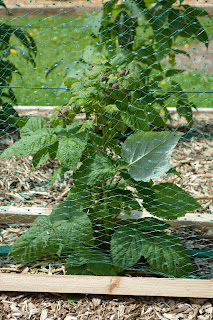 It was looking splendid - the potager and its attendant plots, but when Nature's involved well, it's always unpredictable.
It was looking splendid - the potager and its attendant plots, but when Nature's involved well, it's always unpredictable. I received a phone call from JC to say the potager had taken a serious hit. There'd been a violent hail storm over Ymeray. The hail stones were large and stayed on the ground for more than two hours, and were 2cm deep. Many of the plants couldn't handle being decapitated, shredded and peppered with icy bullets only to be then frozen.
I received a phone call from JC to say the potager had taken a serious hit. There'd been a violent hail storm over Ymeray. The hail stones were large and stayed on the ground for more than two hours, and were 2cm deep. Many of the plants couldn't handle being decapitated, shredded and peppered with icy bullets only to be then frozen.Sensitive plants like the cucumbers, tomatoes and especially the bell peppers were struggling to survive after the onslaught and by the time I got to Ymeray three days later the damage was even more noticeable. It was so disappointing to see what had been such an aesthetic glory was frizzled, chopped and beheaded. Even the soil structure had changed on the surface. All the hail impacts had brought the fine clay particles to the surface and it looked awful. Water no longer sank down, it ran across the ground.
I sprang into action. I dug everything over by hand, tidying what I could and I watered, deeply, to counteract the shock. It should have been done right away but that hadn't been possible. It was going to take many weeks, lots of love and attention and resowing in places where there were casualties but I was determined to get the garden's former beauty back, somehow.
 In the meantime it's doing it's best to recover after a few weeks
In the meantime it's doing it's best to recover after a few weeks . There's also been a bird attack on my just turning strawberries and raspberries. JC has now decided NOT to feed the birds next winter as his generosity has allowed populations to get a bit cheeky and out of balance. We found some old netting and I came up with a way to weigh it down on both sides by stapling the bottom to stakes.
. There's also been a bird attack on my just turning strawberries and raspberries. JC has now decided NOT to feed the birds next winter as his generosity has allowed populations to get a bit cheeky and out of balance. We found some old netting and I came up with a way to weigh it down on both sides by stapling the bottom to stakes.The support lines for the raspberries have their own tension lines, as you can see.
 Lawn clippings are used extensively on the potager as a mulch to conserve moisture, keep the weeds down and to add texture and nutrients to the soil. It also keeps the plants warmer in the evenings.
Lawn clippings are used extensively on the potager as a mulch to conserve moisture, keep the weeds down and to add texture and nutrients to the soil. It also keeps the plants warmer in the evenings.All stakes have been manufactured on site from trees that used to grow on the property. Nothing has been wasted, including off-cuts and bark. Everything has gone into constructing the garden beds.
In wet weather I can walk on the mulch or planks.
 Roses have been chosen for their perfume. Invasive plants, like the mint, have been planted inside their pots to keep them under control.
Roses have been chosen for their perfume. Invasive plants, like the mint, have been planted inside their pots to keep them under control.Space has been used vertically to be able to garden more intensively (strawberries and cucumbers encouraged to climb).
Vegetables have been chosen not just for their food value but also for colour and form as part of garden design. Colourful veggies include the chards (silver beets in various colours), lettuces (especially the sort where you can just detach individual leaves instead of killing the whole plant), cabbages, beetroot. The artichoke was chosen for its architectural merit.



Happily I'm now seeing embryonic brussels sprouts appearing, the cabbages are making 'head' way and the broccoli is also 'coming to a head'. We've been eating lots of lettuces and radishes, salad onions and courgettes. Dreaming of my parsnips roasted and then drizzled with butter, my tomatoes and basil holding hands with slices of mozzarella on a pizza...Payback time!!













1 comments:
oh... Mother nature... create the world and can destroy it in a minute... A video clip voiced by Juliet Robert says it all... it is on the face book. you should listen.
Post a Comment
I welcome your comments, contributions and feedback.